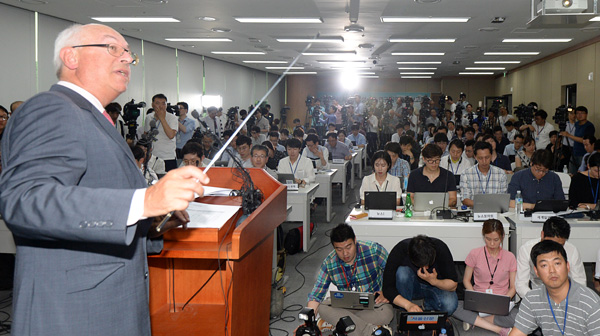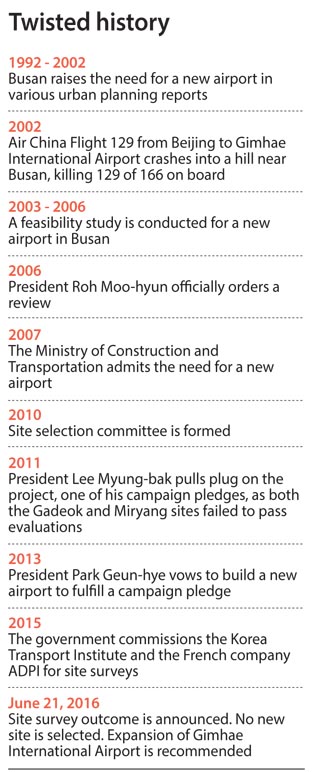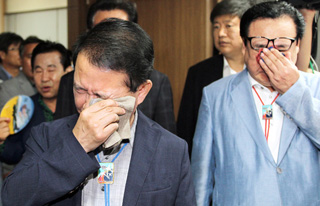New airport vow is scaled down to expansion plan

Jean-Marie Chevallier, a senior engineer of ADPI, presents the feasibility study outcome on the new southeastern airport project Tuesday at the government complex in Sejong City. Based on the study, the government scrapped a plan to build a new airport and decided to expand Gimhae International Airport in Busan. [NEWSIS]
The Ministry of Land, Infrastructure and Transport announced Tuesday afternoon that it will expand Gimhae International Airport instead of building a new facility in the southeastern region, based on a feasibility study conducted by a French company.
Gadeok Island off the city of Busan and Miryang in South Gyeongsang were the primary competitors for the massive infrastructure investment.
Often referred to as the Yeongnam new airport project, the plan was estimated to be worth at least 10 trillion won ($8.6 billion). The Yeongnam region comprises the cities of Busan, Daegu and Ulsan, and the provinces of North and South Gyeongsang.
Last year, the ministry commissioned the Korea Transport Institute and ADPI, a French company specializing in airport planning, to conduct a feasibility study. The outcome was announced by Jean-Marie Chevallier, a senior engineer of ADPI, in a live televised conference Tuesday.
He said a complete review was conducted from square one rather than just looking at the two competing sites. The conclusion to expand Gimhae was reached primarily based on cost-effectiveness, he said.
According to the ADPI report, the expansion of Gimhae International Airport is estimated to cost about 4.39 trillion won, cheaper than building one runway in Miryang.
Building an international terminal alone in Miryang would cost more than 4.78 trillion won, while constructing both international and domestic terminals would cost about 6.14 trillion won.
The option of building a new airport on Gadeok Island was considered the most expensive. Building an international terminal in Gadeok would cost nearly 7.9 trillion won, while building both international and domestic terminals would cost nearly 10.76 trillion won, the report said.

“The government sees the conclusion as reasonable because the study comprehensively reviewed all necessary factors including aviation safety, cost-effectiveness, accessibility and environment,” Kang said. “The proposed expansion of Gimhae airport will be more than a simple reinforcement of the existing facility. It is a proposal to build new runways and terminals while improving the transportation network to access the airport.”
Kang said the expansion plan will accommodate growing demand in the region. The ADPI report showed that the southeastern airport is expected to accommodate 40 million passengers including 28 million international travelers. About 360,000 tons of cargo are also expected to be transported through the facility annually.
Kang said the decision was based on methods agreed to by five concerned local governments.
Kang said another feasibility study will be conducted this year for the expansion of Gimhae, and basic planning will start next year.
Roads and railways to the airport will also be expanded, he said, promising that the government will do its best to quickly proceed with the plan.
Ground-breaking is expected to take place around 2020.
The controversy surrounding a new Yeongnam airport dates back to December 2006, when the Roh Moo-hyun administration proposed constructing a new southeastern airport by 2025 with a capacity to handle 10 million passengers annually.
During his 2007 campaign, presidential front-runner Lee Myung-bak pledged to realize the plan, provoking ferocious competition.
After Lee won the election, a total of 35 proposed sites were reviewed, and the competition was narrowed down to Gadeok Island and Miryang.
In 2011, Lee pulled the plug on the project and apologized to the nation for having reneged on his promise. He said he could not responsibly push forward a project destined to lose money. His administration faced fierce blowback.
At the time, Park Geun-hye, Lee’s political rival, said it was a shame that Lee broke a promise made to the nation and vowed to revive it as a pledge in her 2012 presidential campaign.
After winning the election, Park in 2013 made the new airport plan an official project of her administration.
The local governments of Busan, Daegu, Ulsan and North and South Gyeongsang agreed in 2015 that they would not hold a competition, delegating an independent foreign specialist to make the decision.
The Ministry of Land, Infrastructure and Transport commissioned ADPI on June 25, 2015, to conduct a feasibility study. After a year of review, the outcome was announced Tuesday.

Leaders of a civic group championing a new airport in Miryang shed tears after the new airport plan was nixed on Tuesday. [GONG JEONG-SIK]
The latest conclusion was similar to a 2011 decision made by the Lee administration. After ruling both sites of Gadeok Island and Miryang unsuitable, the government at the time decided that it was more cost-effective to expand an existing airport in the region. However, it did not specify which airport should be expanded.
Completed in 1976, Gimhae International Airport is used by about 10 million passengers annually. It is Korea’s second largest international airport after Incheon International Airport. The Air Force’s 5th Air Mobility Wing is stationed at Gimhae, using about 30 percent of the facilities.
Reactions were varied.
Busan Mayor Suh Byung-soo said he would not accept the decision, promising to win the project for Gadeok Island and vowing to step down if he fails to do so.
Daegu Mayor Kwon Young-jin held a press conference to denounce the decision. “History was rewound by 10 years, and I am furious about this preposterous decision,” Kwon said.
The leadership of the ruling and opposition parties generally supported the decision, but individual lawmakers representing the affected areas strongly protested.
Saenuri Party floor leader Rep. Chung Jin-suk said the government made a difficult decision and the country must respect it for the greater good. Acting Chairman Kim Chong-in of the main opposition Minjoo Party also said the decision was reasonable and impartial.
Liberal politicians said the Park administration should be held accountable for a wasteful debate and reigniting the controversy.
“The government is largely responsible for having restarted a serious conflict,” said Rep. Park Jie-won, floor leader of the People’s Party. “After 10 years of controversies, it went full circle and a decision was made to expand Gimhae.”
He also said the National Assembly will review the government’s decision-making process over the project.
BY SER MYO-JA [ser.myoja@joongang.co.kr]










with the Korea JoongAng Daily
To write comments, please log in to one of the accounts.
Standards Board Policy (0/250자)